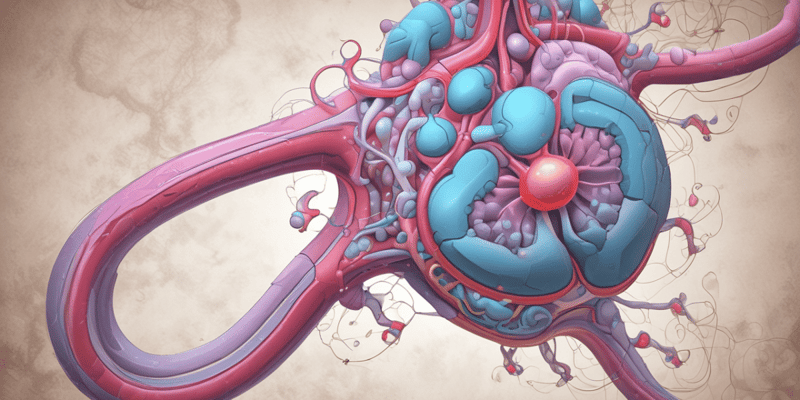20 Questions
Where does gas exchange occur?
In the alveoli
What feature of alveoli allows for efficient gas exchange?
Large number of alveoli and a large number of capillaries
What is the thickness of the alveolus wall?
One epithelial cell thick
What is the thickness of the capillary wall?
One endothelial cell thick
What is the result of the large number and thin walls of alveoli and capillaries?
A massive surface area for gas exchange
What is the primary function of the alveoli?
To facilitate the exchange of oxygen and carbon dioxide
What is the significance of the large number of alveoli?
It increases the surface area for gas exchange
What is the advantage of the close proximity of alveoli and capillaries?
It increases the rate of gas exchange
What is the benefit of the thin walls of the alveolus and capillary?
It allows for faster diffusion of gases
What is the result of the combination of the large number of alveoli and the close proximity of alveoli and capillaries?
An increase in the surface area for gas exchange
What is the purpose of the serous fluid secreted by the pleural membrane?
To reduce friction between the pleural surfaces
What is the name of the double layer of pleura that divides the thoracic cavity?
Mediastinum
What is the purpose of the pleural membrane?
To secrete a fluid that reduces friction
What is the name of the cavity that lies between the two layers of pleural membranes?
Pleural cavity
What is the characteristic of the pleural cavity?
It contains a vacuum and a small volume of pleural fluid
What is the main function of the serous fluid produced by the pleural membrane?
To reduce friction between the pleural surfaces during respiration
What is the name of the double layer of pleura that divides the thoracic cavity into two pleural cavities?
Mediastinum
What is the characteristic of the space between the two layers of pleural membranes?
It is a vacuum with a small volume of pleural fluid
What is the purpose of the pleural membrane in the pleural cavity?
To cover and protect the structures in the pleural cavity
How many pleural cavities are found in the thoracic cavity?
Two
Study Notes
Alveoli and Gas Exchange
- Gas exchange, involving oxygen (O2) and carbon dioxide (CO2), takes place in the alveoli and surrounding capillaries.
- Efficient gas exchange is facilitated by several features.
Features of Alveoli for Efficient Gas Exchange
- A large number of alveoli exist, each surrounded by a large number of capillaries, ensuring a high density of gas exchange sites.
- Each alveolus has a thickness of only one epithelial cell, minimizing the distance for gas diffusion.
- The capillary wall is only one endothelial cell thick, further reducing the distance for gas diffusion.
- The massive surface area for gas exchange is a result of the large number of alveoli and their thin walls.
Alveoli and Gas Exchange
- Gas exchange, involving oxygen (O2) and carbon dioxide (CO2), takes place in the alveoli and surrounding capillaries.
- Efficient gas exchange is facilitated by several features.
Features of Alveoli for Efficient Gas Exchange
- A large number of alveoli exist, each surrounded by a large number of capillaries, ensuring a high density of gas exchange sites.
- Each alveolus has a thickness of only one epithelial cell, minimizing the distance for gas diffusion.
- The capillary wall is only one endothelial cell thick, further reducing the distance for gas diffusion.
- The massive surface area for gas exchange is a result of the large number of alveoli and their thin walls.
Thoracic Cavity
- The thoracic cavity is divided into right and left pleural cavities by a double layer of pleura called the mediastinum.
- Each pleural cavity is lined by a single layer of serous membrane, the pleural membrane.
- The pleural membrane secretes a small amount of serous fluid, which reduces friction between the pleural surfaces during respiration.
- The pleural membrane covers all structures within the pleural cavities and is named according to the structures it covers.
- The pleural cavity lies between the two layers of pleural membranes and contains a vacuum and a small volume of pleural fluid.
Thoracic Cavity
- The thoracic cavity is divided into right and left pleural cavities by a double layer of pleura called the mediastinum.
- Each pleural cavity is lined by a single layer of serous membrane, the pleural membrane.
- The pleural membrane secretes a small amount of serous fluid, which reduces friction between the pleural surfaces during respiration.
- The pleural membrane covers all structures within the pleural cavities and is named according to the structures it covers.
- The pleural cavity lies between the two layers of pleural membranes and contains a vacuum and a small volume of pleural fluid.
Learn about the process of gas exchange between alveoli and capillaries, and the features that facilitate efficient exchange of oxygen and carbon dioxide.
Make Your Own Quizzes and Flashcards
Convert your notes into interactive study material.
Get started for free




